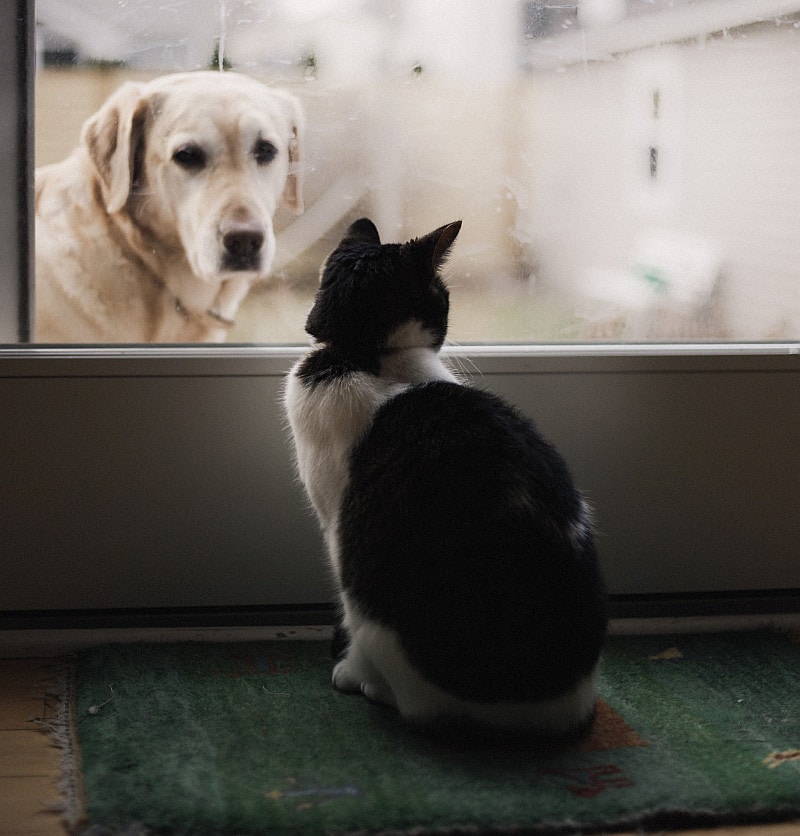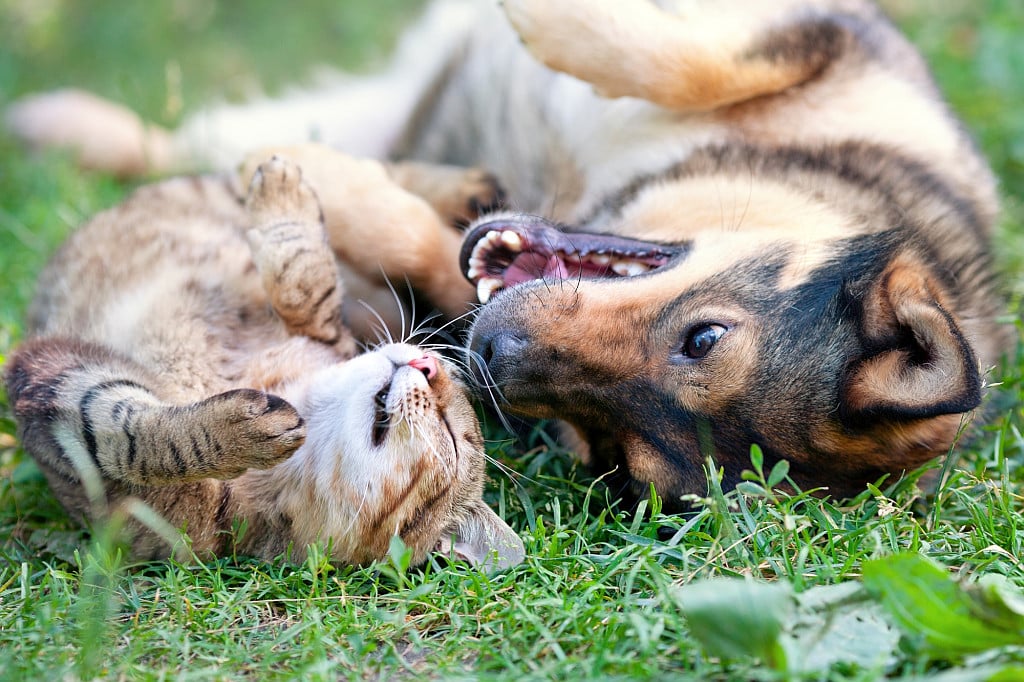There can be no doubt that cats and dogs seldom get along. If not for their mutual love of humans, these two animals would probably avoid each other like the plague. However, they do not have that option, and neither do you if you happen to own both of these animals. Most dogs are capable of killing a cat, so you have to be careful about how you introduce dog to a cat.
Preparing to Bring Your New Pet Home
Regardless of whether you are buying a cat or a dog, there are certain things you can do to prepare yourself, your home, and your other pets for the new arrival. The process of introducing cats and dogs will be greatly aided if you are working with young animals. If you raise a puppy and a kitten together, they will often become friends. At the very least, it is better if one of the animals is a puppy/kitten. This method works because younger animals are less intimidating in general.
You must also consider the personality of your current pets. Some dogs are extremely aggressive toward cats and simply too antisocial to make friends with another animal. As for cats, there are many that seem to despise dogs, hissing at the very sight of them. Animals like this are going to make your job a lot more difficult. Don’t attempt to do this with the most aggressive of cats or dogs.
When Bringing Home A Cat
It is a good idea to give your cat a “retreat” of some kind. It should have an opening that a dog cannot fit through, no matter how hard they try. If your dog is aggressive at all, this is a necessary precaution. By doing this, you also help to defuse tensions by giving the cat a way to avoid the dog if they so desire.

You can also give your cat some high places to climb. Dogs are generally not able to climb very well, and very few can jump as high as a cat. Giving your cats a few good perches within jumping range can give them another way to get the solitude that they will occasionally desire.
Your dog might very well see your cat as an intruder since most dogs are naturally territorial. That is why you need to be extra careful in this situation. If you have a large dog, the risk is even higher, so take your time and introduce them very slowly.
When Bringing Home A Dog
Like dogs, cats tend to be territorial, the cat probably doesn’t pose a danger to your dog’s life, but they can definitely do some damage if they have a mind to do so. If your dog is a small one, the cat might very well bully the dog. This situation isn’t as risky as the reverse, so you can probably take a little less time.
As soon as you bring the new dog home, you should immediately begin working on basic commands. Start with the basics: sit, shake, lie down, stand up, stay, etc. You can also train them for aggression control by playing with them, and scolding them when they bite too hard. While you are doing this, be sure to pay attention and learn your dog’s body language. This will allow you to predict their behavior with quite a bit of accuracy.
Keep Your Cat and Dog Separate at First

For all the reasons discussed above, you cannot simply throw two animals together and expect them to get along. You need to keep them separated until they can get used to one another.
Phase One
You may not be able to bring the animals together at present, but you can bring their smell together. Simply having them in the same house will allow your pets to get used to the smell of the other, and that’s a good start. In phase one, the idea is to mix their scents as much as possible without allowing physical interaction.
Use whatever means you need to keep them separated. Common methods include:
- Use of cages
- Confinement in separate rooms
- One pet in the house, one in the yard
- Pet gates
- Areas that are too small for the larger animal to reach
To help this process along, you can use this method. Buy two cheap blankets and put one in each cage. After a day or two, switch the blankets. Both animals will probably curl up on the blankets and spend a large portion of their day sleeping comfortably. As they do this, they will be smelling the scent of the other animal and making a positive association. Repeat the process by switching the blankets every few days so that the scents can be renewed.
It is hard to understate the importance of smell in the world of a dog or a cat. While dogs definitely have a more sensitive nose, cats still get a lot of information about the world from their sense of smell.
Phase Two
In phase two, we will try to create a positive association between your animals. Animals tend to judge by experience above all, so the idea is to give them a good experience with the other animal.
Up until now, your animals should have seen little to none of one another. Now, you will allow them to see one another, but only at feeding time. The easiest way to do this is to put two cages in the same room and let them eat. There may be some hissing and growling at first, but they will eventually eat.
Pay attention to the reactions of the animals to gauge your progress. Over time, the growling and hissing should die down. When they begin to calm down, you can move the cages closer together and see what kind of reaction that produces. If they begin to get more aggressive or nervous, offer both of them a treat at the same time.
Supervising The First Meetings

The next part of the process is to allow the first physical interactions in a controlled environment. If you have followed the instructions in the previous section, this should be safe. However, you still need to be careful at this stage. Keep the meetings short and supervise them closely.
Before doing any of this, you will need to learn more about the signs of aggression that cats and dogs commonly exhibit. While these signs are different for each animal, most are easy to recognize.
Warning signs of feline aggression include:
- Stiffening of the legs and raising of the back
- Screeching and spitting
- Hissing
- Fur standing on end, resulting in a bushier-looking tail
- Stalking behavior
- Pouncing
- Scratching, sometimes in rapid combination strikes
- Ears flattened back against the head
Warning signs of canine aggression include:
- Sudden stiffening of the body
- Low, guttural barking
- Lunging or charging attempts
- Growling
- Lifting lips to show teeth
- Snarling
- Biting or opening the mouth in a threatening manner
- Lowering the head and widening the stance
- Circling and snapping
Begin by bringing both caged animals into the room as before. Bring the cages right next to each other and see if they try to fight through the bars. If they do, you need to pull the cages apart slightly and wait a little longer before moving to this part of the process.
If they don’t show any aggression, release one of them. See what happens. If no signs of aggression are noticed, release the other animal. This is where you need to exercise the closest control.
Obviously, the dog poses a greater threat, so make sure that you have a strong and short leash combined with a good collar or (better yet) a harness. Depending on the size and temperament of your dog, you should consider the use of a muzzle. As for the cat, just make sure that the room doesn’t give them an opportunity to escape to the outside. Otherwise, they may run away in fear and never come back.
It is best to hold the dog closely, making them sit calmly. You may need to offer them a treat to make this happen. Keep the leash somewhat tight and make the dog stay in place. As for the cat, just leave them alone and let them do their thing.
This method works by taking advantages of the differences in canine and feline behavior. While dogs benefit from close supervision and firm control, cats are more independent and do not respond as well to that kind of thing. As such, you need to let your cat make contact with this new creature on their terms.

It is entirely possible that the cat will just hide under the nearest piece of furniture and refuse to come out. If that happens (and there is a very good chance that it will happen at the first meeting), don’t worry too much. Keep the dog in place and give your cat a chance to come out and say hello. If they don’t do this after 20-30 minutes, they probably won’t come out at all. Put the animals back in their places and try again tomorrow.
How to Introduce a Cat to a Dog That Hates Cats
If you are dealing with a dog with a more aggressive demeanor, you will need to change the training methods accordingly. First of all, make sure you have a very strong cage to hold the dog. This is important because you already know that they will flip out when they see a cat. If the cage fails, you will have a dangerous situation on your hands, so spend a little more and get a reinforced steel cage.
Put a muzzle on the dog, and put them in a small cage. Bring this cage into a room, and preferably an empty one. Feed the dog and give them some water while praising and reassuring them verbally. Let the dog get nice and relaxed, and then bring in the cat.
The cat should not simply be tossed into the room, as it may wander too close to the cage and get hurt. Instead, put the cat in a carrier and allow the dog to look at them and get their scent. You will need to take your time and let the dog get used to the cat before moving on.
As before, you can use treats, toys, and other rewards to try and create a positive experience for the animals to share. Keep a close eye on both animals and separate them if they show any signs of serious aggression.
Repeat Sessions Daily
Don’t try to rush this process along. Good results take time, and there is no way around that fact. You will need to repeat these short visits every day until you feel confident that your animals are not going to fight.
It is important not to freak out if your animals play-fight to a certain extent. This is actually a good sign, as it will usually prevent more serious aggression. That being said, you will need to be a good referee and separate them when necessary.
Most of the time, serious aggression will be accompanied by a lot more noise from both animals. Snarling from the dog or screeching from the cat are both warning signs that it’s time to break things up. If one of them just doesn’t want to play, separate them before they become irritated and start a real fight.
Even after you have achieved significant progress here, you should be very careful about leaving the animals alone together. When you leave the house, the animals must be separated in such a way that there is no possibility of contact.
Unsupervised Interactions – When And How To Proceed?

At this point in the process, your animals should be able to get along fairly well. However, there is a lot to consider before taking this final step. First, consider how roughly your animals play with one another. If you regularly have to intervene and break them up, they are not yet ready for unsupervised interaction.
If your animals are still very shy of one another and keep their distance, they are also not ready for this part of the process. Even if they are tolerant of one another, a small conflict could quickly become a big deal without your supervision. One of the things that keep your animals from fighting is their mutual respect for you.
If you are stuck at one stage of the process and no progress is being made, you might want to consider the possibility of letting your animals meet on neutral ground. This can be accomplished through the help of a friend or relative, preferably one that has no indoor pets of their own.
This method is particularly useful in cases where the resident animal remains highly aggressive while the new animal remains calm. By taking the element of territory out of the equation, you can give your pets the chance to overcome their distrust.
Final Thoughts
If you are trying to do this with adult animals, you will most certainly have your work cut out for you. Unless both animals are very young, this will be a slow and gradual process that will require discipline from both you and your pets.
That being said, both of these animals have been companions to the human race since the most ancient times, and their loyalty to their master is often strong enough to transcend their suspicion and dislike of another species. We wish you the best of luck in this endeavor, and we remind you to follow the instructions carefully and take the utmost care every step of the way.
